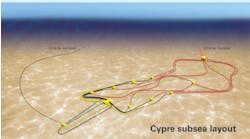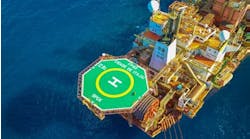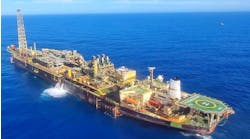To provide cost-effective completion solutions in remote locations a number of companies have turned to the relatively novel concept of unmanned control buoys. While there are two of these solutions in place, the designs are unique, an indication of the flexibility of this solution and a hint of things to come. The control buoy is by necessity a low-cost production solution.
Kvaerner and Mentor Subsea have each been involved in a completion solution that centers around a control buoy system. Mentor has aligned with a company called Ocean Resources to pursue a variety of control buoys for the industry. At the same time, Halliburton is developing the concept of a compliant buoy that would offer many of the same features, but would have a different profile.
NCC buoy
The first of these solutions to go into service was Kvaerner's "vertical submarine" on the East Spar development off NorthWest Australia. This buoy resembles a mini-TLP with four legs extending out from the center tube below the water line. Each of the legs is connected to two structural strand-wire tendons, anchored to the seabed by a gravity base. Kvaerner calls this a navigation, communication, and control buoy or NCC. The buoy communicates with the shore using a UHF radio signal. For the radio communication system to operate properly, the antenna has to remain nearly vertical. This was a challenge for the design of the buoy and anchoring system, and stability is one of the chief advantages to this concept. Other requirements considered in choosing this novel solution were the need to monitor valves, perform chemical injection, and provide power to the subsea completion.
The buoy itself is shaped much like a fishing cork and is divided into five levels. Level one houses the radio, telemetry equipment, and buoy control system in one compartment and the ventilation system in another. Level two is also divided into two compartments, each houses two diesel-powered generators. Only one of these generators is required to run the facility; the other three act as backups. Level three contains the main power distribution system and battery backup equipment in one compartment. In the other is the hydraulic power unit consisting of four pumps, two high-pressure and two low pressure, which charge the accumulator bottles to operate the subsea system. Level four houses the fluid storage tanks, chemical injection system, corrosion inhibitor, and MEG. Level five, the lowest level, contains the chemical injection pumps, diesel storage tanks, subsea uninterruptible power supply, and batteries.
The buoy had to be accessible by personnel. This too became a question of stability. To eliminate most of the buoy's motion, an unusual mooring system was designed. Four sets of spiral strand wire tendons connect the buoy to the gravity base imbedded in the seabed. The tendons are connected top and bottom with chains.
The tether arms that connect the tendons to the buoy increase the wave loading, but improve the motion of the tension leg system. The legs are connected to the buoy below the wave zone. The tension on these four legs reduces the motions of the buoy to horizontal surge and sway. While the NCC is a novel concept, Earl Piemattei, Technical Director with Kvaerner Oil & Gas, said it has held up very well in adverse conditions. Soon after its installation, the buoy withstood one of the most severe storms to pass over the area in years. Piemattei said the buoy not only weathered the storm, but also maintained contact with the shore.
Sea Commander
Following Kvaerner's buoy success off Western Australia, Ocean Resources has installed the second control buoy system, Sea Commander, offshore South Africa. The buoy was installed on the Mossgas E-M Field. Like the East Spar installation, this buoy system is based on an earlier Ocean Resources design patented for the military, called Sea Sentinel. The Sea Sentinel is a data acquisition buoy and is the predecessor to the buoys now in place.
Ocean Resources has been able to transfer the knowledge gained on Sea Sentinel to the commercial market, according to Phil Hands, Director of Ocean Resources. The major advantage of this design is that it remains vertical in virtually all sea states.
Ocean Resources recently formed a partnership with Mentor Subsea Technology Services, Inc. (Mentor), a J. Ray McDermott company, to market and promote several buoy concepts. Neal Mackintosh, Division Manager with Mentor, said the partnership is already looking at a number of alternative solutions.
In deepwater, for example, the buoy would fit somewhere between a mini-TLP and a subsea tieback to a host platform. Among the options under consideration are:
- Sea Commander, for controlling remote satellite fields and eliminating the need for umbilicals tied back to a host platform
- Sea Booster, which uses the Sea Commander control facilities and features injection facilities and an on-board power supply to boost production pressure and distribute power
- Downhole electrical submersible pumps (ESP)
- Mudline supported multiphase pumping systems.
Other concepts that will move control buoys into the next generation are the Sea Producer, offering controls systems, water injection, and production processing and storage; and the Sea Intervener, equipped for manifold equipment intervention, retrieval and installation, and well testing. The Sea Intervener would include a mini-moonpool for vertical intervention access as well as coiled tubing and wireline intervention equipment.
For deepwater operations, there is a variation on the four leg tendon and gravity base design. Well below the wave zone, a ring would allow the tendons to drop vertically from the surface, then span out to be anchored by four separate gravity anchors. The mid-water float, as the ring is called, would be moored to the anchors by polyester rope and should provide stability similar to that of shallow water buoys.
Compliant buoy
While stability has been the watchword for the buoy designs currently in place, Brown & Root Energy Services (BRES), a business unit of Halliburton Co., has designed a compliant buoy that moves with the waves and current. This buoy design is similar to those used in the oceanographic meteorological industries. The circular buoy is about 75 ft in diameter with a draft of 30 ft. This low profile allows the buoy to conform to the motion of the waves. While still in the design phase, the buoy will be part of a deepwater marginal field completion system equipped to control the subsea wellheads, perform well intervention, testing, pigging, and flow assurance. While there will be fluids stored on the buoy, it is designed to work in connection with a host facility through a tieback of 20 miles or more.
The buoy will offer direct access to and control of the wells and flowline from a hybrid riser umbilical. The flexible hybrid riser will run from the buoy to the seafloor with a 4-in. high-pressure bore in its center, and electrical, fiber optic, and fluid lines on the outside.
This high-pressure bore can be used to melt hydrate plugs by de-pressurizing the backend of the flowline. The riser bore can also transport gel pigs to the flowline, or perform a production test on a well. Use of the riser bore will require manned intervention in the form of a work vessel moored to the buoy. The buoy would be held in place by a synthetic taut mooring system.


